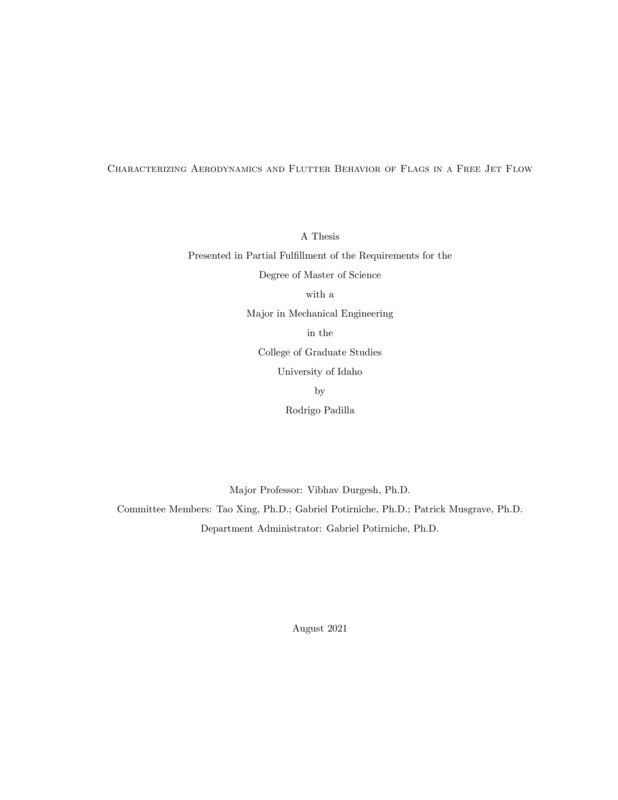Characterizing Aerodynamic and Flutter Behavior of Flags in a Free Jet Flow
Padilla, Rodrigo. (2021-08). Characterizing Aerodynamic and Flutter Behavior of Flags in a Free Jet Flow. Theses and Dissertations Collection, University of Idaho Library Digital Collections. https://www.lib.uidaho.edu/digital/etd/items/padilla_idaho_0089n_12218.html
- Title:
- Characterizing Aerodynamic and Flutter Behavior of Flags in a Free Jet Flow
- Author:
- Padilla, Rodrigo
- ORCID:
- 0000-0002-3732-2279
- Date:
- 2021-08
- Keywords:
- Flags Fluid-Structure Interactions Flutter
- Program:
- Mechanical Engineering
- Subject Category:
- Mechanical engineering
- Abstract:
-
Fluid-Structure-Interaction (FSI) is a widely studied research area in the field of fluid dynamics since a detailed understanding of FSI flow behavior can impact a wide range of engineering applications like new generation parachutes used in space exploration, helicopter aerodynamics, bio-propulsion, and flexible wing aerodynamics. However, developing a detailed understanding of the underlying physics in an FSI flow can be challenging due to the non-linear nature of the coupling between fluid flow and structures. Therefore, this investigation aims to quantify the FSI behavior of a flag in uniform jet flow, specifically the aerodynamic performance, flutter movement, and fluid flow velocity around the flag. For this purpose, three flag samples of varying lengths were used, and experiments were performed for a range of three critical non-dimensional parameters, i.e., Mass Ratio (R1), Dimensionless Rigidity (R2), and Reynolds number (Re). The R1 and R2 values were varied from 1.48 to 2.77, and 1.3 x 10-3 to 14.4 x 10-3, respectively, and Reynolds Number was varied from 44 x 103 to 123 x 103. All experiments were conducted in the sub-sonic open jet facility at the University of Idaho's Experimental Fluids and Aerodynamics Laboratory. The aerodynamic load experienced by the flag was measured using a high-precision load cell. The flag movement was captured using a triggered image acquisition system, and Particle Image Velocimetry (PIV) was used to measure the velocity fields around the fluttering flag. The results showed that the longest flag model has a unique aerodynamic load characteristic, i.e., a drag crisis region for R2 from 3.1 x 10-3 to 5.3 x 10-3 followed by a drag recovery region for R2 from 1.9 x 10-3 to 3.1 x 10-3. All the studied flag models start oscillating with increasing Re and exhibit mode-2 oscillation behavior. With the further increase in Re, the longest flag model transitions from mode-2 to a mode-3 oscillation. Furthermore, these results suggest that the flag movement and oscillation modes contribute to observed drag by these models. Finally, the stability plots identify a new region highlighting the transition from mode-2 to mode-3 oscillation behavior.
- Description:
- masters, M.S., Mechanical Engineering -- University of Idaho - College of Graduate Studies, 2021-08
- Major Professor:
- Durgesh, Vibhav
- Committee:
- Xing, Tao ; Potirniche, Gabriel ; Musgrave, Patrick
- Defense Date:
- 2021-08
- Identifier:
- Padilla_idaho_0089N_12218
- Type:
- Text
- Format Original:
- Format:
- application/pdf
- Rights:
- In Copyright - Educational Use Permitted. For more information, please contact University of Idaho Library Special Collections and Archives Department at libspec@uidaho.edu.
- Standardized Rights:
- http://rightsstatements.org/vocab/InC-EDU/1.0/

